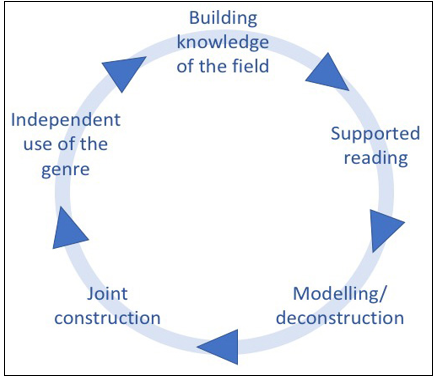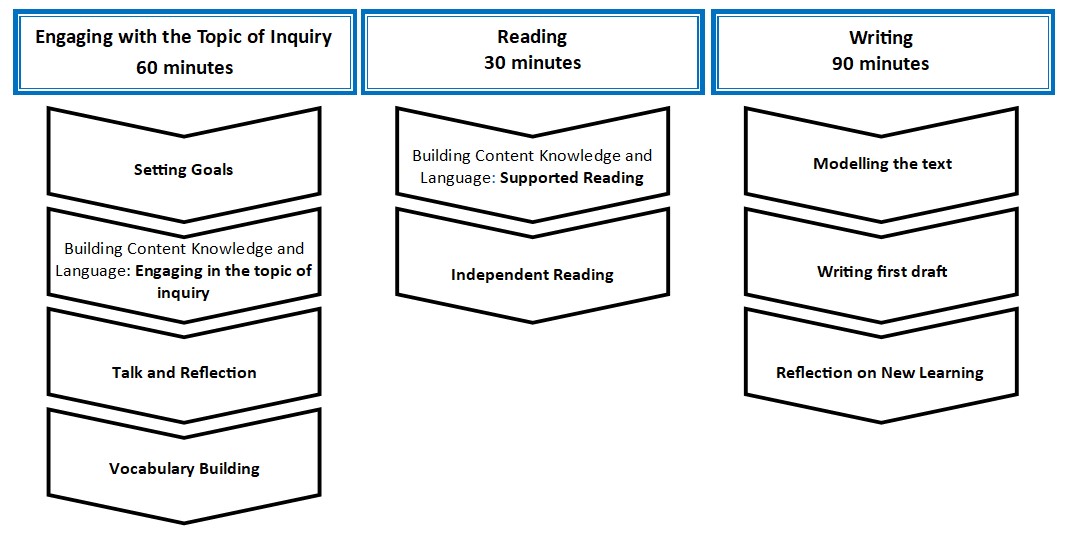
Adapted from Derewianka, B. & Jones, P. (2016). Teaching Language In Context (2nd ed.). South Melbourne, Victoria: Oxford University Press.
The Teaching and Learning Cycle is usually taught over an extended period of time. The example provided here addresses how a teacher may begin an inquiry unit of work, commencing with Building the Field and Supported Reading, providing students with opportunities to read and write about their initial investigations.
This early drafting phase allows students to use new content and language knowledge to
- write notes,
- draw labelled diagrams, or
- to write a more extended text based on topic focus.
The complete cycle of Building the Field (including Supported Reading, Modelling or Deconstruction, Joint Construction and Independent Construction) could involve
- excursions,
- incursions,
- visiting speakers,
- experiments,
- reading and viewing multiple texts and
- multiple opportunities for writing.

Teaching and Learning Cycle example in detail
Each of the phases for the Example Language Experience are explained below, expand each accordion to view details of the teacher and student roles of each phase of the Workshop.
The full Teaching and Learning Cycle approach table can be viewed here.
Engaging with the Topic of Inquiry (approximately 60 minutes)
Setting Goals
Building Content Knowledge and Language : Engaging in the topic of inquiry
Teacher led:
Students:
- activate and use prior knowledge to make connections.
- ask and answer questions about the text.
Talk and Reflection
The teacher:
Students:
- practice extending their responses.
- practice building on each other's responses.
- practice accountable talk.
Vocabulary Building
Teacher led:
-
vocabulary building instruction, related to the topic of inquiry, particularly Tier 1 and 2 words, with some Tier 3 words.
-
intentional discussion of word meanings in context, using student- friendly definitions.
- modelling of hearing and saying sounds in new words.
Students:
- practice reading and pronouncing new words.
Reading (approximately 30 minutes)
Building Content Knowledge and Language: Supported Reading
The teacher:
Teacher led:
Students:
- contribute to the reading through asking and answering questions.
- interpret visual information.
- use new vocabulary and grammatical knowledge in their questions and responses.
Independent Reading
The teacher:
Students:
- examine the visual information in the texts.
- discuss their text with a partner or small discussion group.
Writing (approximately 30 minutes)
Modelling the text
The teacher:
- articulates and displays the learning intention and differentiated success criteria for the session.
-
models the text.
Teacher led:
- creates or selects a mentor text relevant to the initial focus of the inquiry.
- deconstructs the text, drawing students' attention to the structure
and the language of the text. - 'thinks aloud' about the writing and foregrounds the classroom resources students can use to assist with the writing.
- draws and labels a diagram to accompany the text where appropriate.
Students:
- discuss, ask and answer questions about the mentor text.
Writing first draft
Teacher led:
Students:
- draw and label a visual text to accompany their draft written text (for example, an illustration or a diagram).
- use the mentor text as an example for their writing (for example, notes, dot points, or a more extended text), incorporating new content and language knowledge.
- access classroom resources to assist in their writing.
- save their draft in hard copy or digital format.
Reflection on New Learning
The teacher:
Students:
- practice extending their responses.
- practice building on each other's responses.
- practice accountable talk.